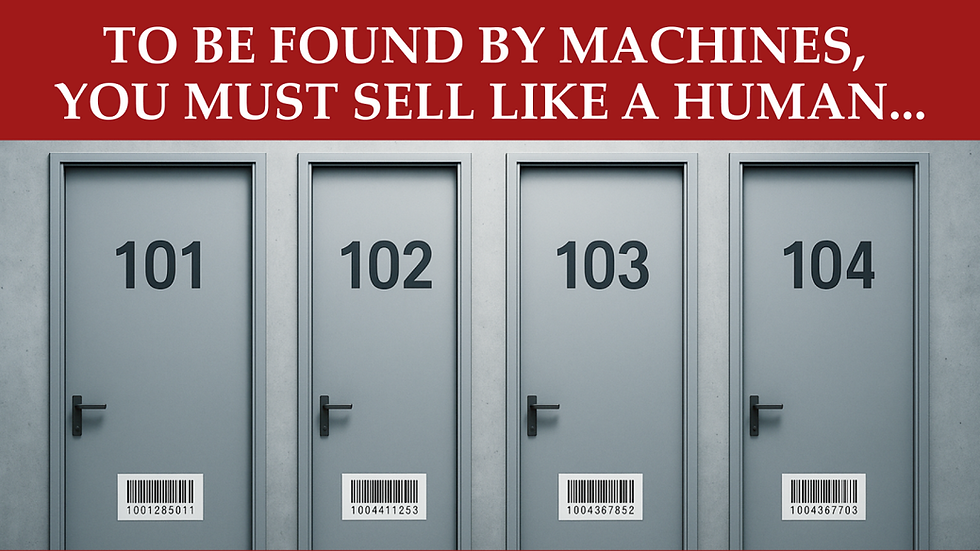Do you really know your property's worth?
- Markus Mueller
- Jun 2, 2021
- 4 min read
The real way to sell your hotel the way it deserves.
May 31, 2021, Markus Mueller, Co-founder GauVendi
Around two decades ago, hotels began clustering their room inventory into simple categories that could easily be sold online. Since then, they have lost control over how their own room inventory is sold and distributed. Third-party booking platforms often drive a large part of a hotel’s revenue and have made hotel products very comparable. They have standardized them for their own needs. In other words, they made real differentiation at point of purchase very difficult for hoteliers, and this has an impact on the hotel product category and their respective brands. After all, an important part of building brand equity is to control your distribution.
Think about brands like Apple or Nike - have they given away how their products are distributed? Differentiation at point of purchase is an extremely important factor when talking about driving direct bookings. Its’ a fundamental part of the overall brand strategy.
What happens if hoteliers break away from traditional room classifications and manage inventory in a very different way? What about redefining the room experience based on feature combinations and room attributes digitalizing all experience dimensions including location, bathroom setups, etc.?
The short answer is: if hoteliers use new technologies that can manage inventory in a more granular way, they can significantly differentiate their direct point of purchase, show higher product transparency and improve guest satisfaction. Hoteliers can get back full control of their inventory, are not easily comparable, can promote a real incentive to guests for booking direct by offering true personalization options and at the same time can repackage their inventory to the needs of all relevant third-party distribution channels to maximize reach and revenue.

In addition, reservation processes and room allocations can be automated, saving labor costs and improve overall inventory management operations.
Kim & Mauborgne published a book called “Blue Ocean Strategy” in 2005, where they mention how Cirque du Soleil reinvented the classical circus in the 1980s by adding acrobatics and taking out the costliest elements of animal husbandry becoming the global champion of their industry.
Changing the way that room inventory is managed and sold is indeed a Blue Ocean brand strategy as well redefining the entire playing field through the point of purchase and giving customers a real benefit to book through cheaper direct distribution channels.
Many hoteliers are talking about selling experiences, but reality shows they are not doing it. They sell Standard Rooms and add-ons at most. Some hoteliers try to differentiate their inventory by renaming their room types to something sexier which creates a lack of transparency for guests. The included features are often not obvious. In addition, third party channels often force those hoteliers to accept the channels’ own labelling standards anyways.
With a feature-based approach, clustering rooms into Room Feature Combinations (RFCs), you can combine labelling tactics and room feature transparency at the point of purchase, allowing to sell the same physical rooms with a different label and price point appealing to different target audiences. In addition, guests can book specific features, as long they are willing to pay for it.
GauVendi’s research has shown that more transparency at point of purchase will trigger even higher willingness to spend.

A feature-based approach also requires the understanding of the own room inventory a lot better. It is pivotal to walk the floor of each room, understanding unique experience benefits of each single room and really listen to your reservation department and repeat guests.
Subject to the size of the property this is more or less time consuming, yet there is significant value to define the room differentiators by more experience dimensions than just layout, size, or bedding type. Location of the room, views, bathroom setups, outdoor spaces or special designs are valuable experience dimensions which can be monetized and should be considered in the pricing strategy.
Knowing your true inventory and the respective experience dimensions is key for a successful and differentiated brand strategy.

To give you some examples, I usually refer to the below six new selling strategies possible with the explained feature-based approach.
The strategies listed mainly focus on selling through direct distribution channels taking a feature-based approach, however the strategies have significant benefits for the entire distribution mix.
Combining the room feature combinations (RFCs) inventory with different rate levels per feature and additional conditions on stay levels, payment and cancellation terms or even allotments, provide multiple opportunities to sell the rooms inventory.
Example strategy for the same inventory product
Let’s assume you have both - apartments and hotel rooms - and you would like to sell your apartment for short periods and long periods subject to the season. With the GauVendi system you can set up your apartments as two separate products attaching different rate plans, selling rules or even different services to it. You can then determine to which channel or point of purchase you like to map this product with – using a channel manager or only offering it on your website, email and voice reservations.
Position your inventory subject to target audience and point of purchase!

A good salesperson would not sell to all customers in the same way So why should you? A good salesperson adjusts the approach geared towards the target audience. With a feature-based sales approach, we can take the same approach set up and package inventory according to the core target channels and audiences.
Imagine you are a sales person of a resort going into negotiations with a tour operator. You could create a specific room product, agree with the procurement person what physical rooms would fit best to the target audience, which room features should be included, agree to different allotment release periods per room product and so on. You would get better performance data, could control customer experiences much better - especially in mass tourism destinations - and give this specific tour operator a sense of exclusivity.
In summary, we see only benefits in such an approach that finally allows the hotelier to take control of their inventory and determine their core sales strategy. It adds a new dimension to revenue management combining room label transparency and willingness to pay, as well as individual room feature price elasticities.
To learn more about a feature-based inventory approach view our four quick video lessons to make yourself familiar with the solution. Find out more here or contact us for a free consultation on gauvendi.com




Comments